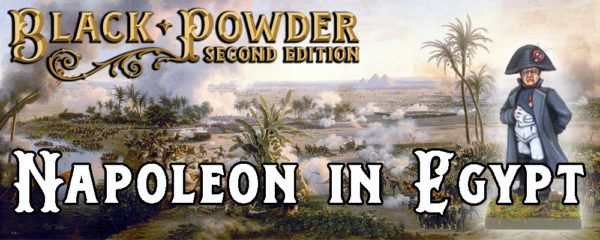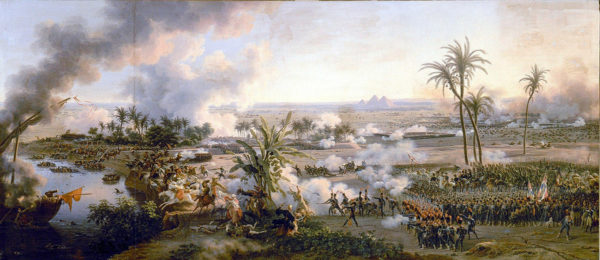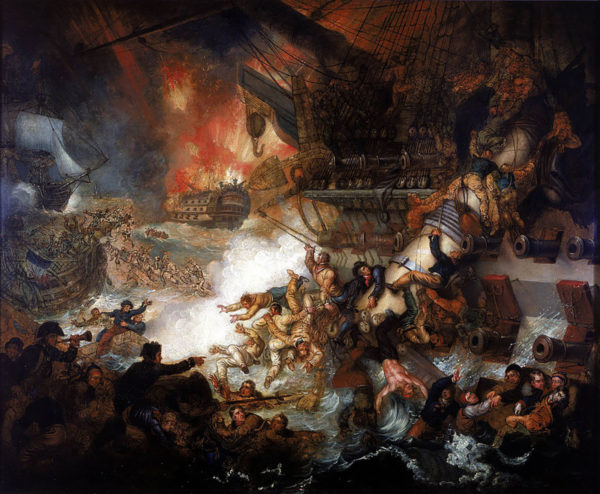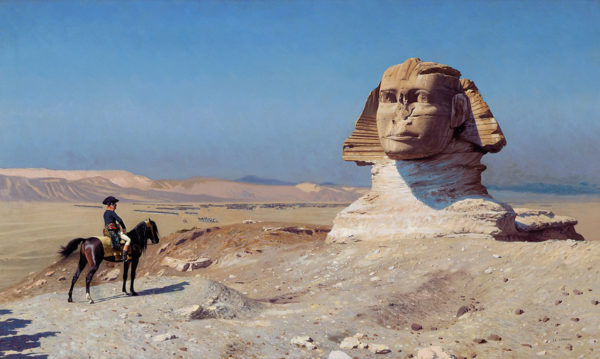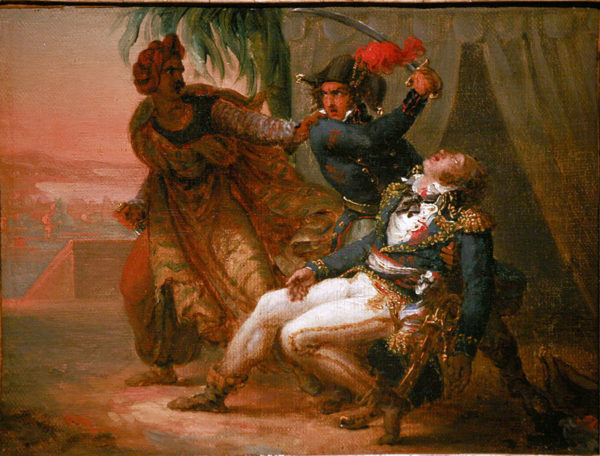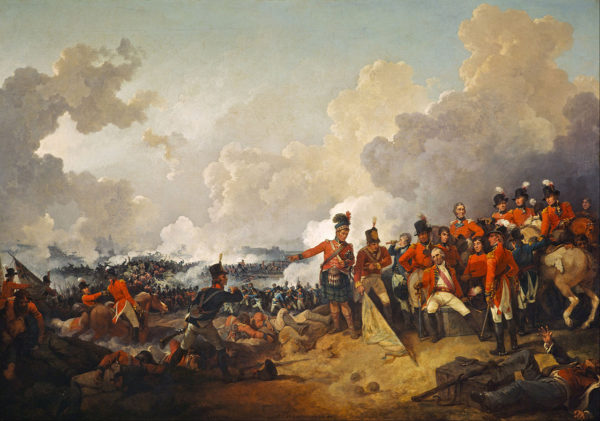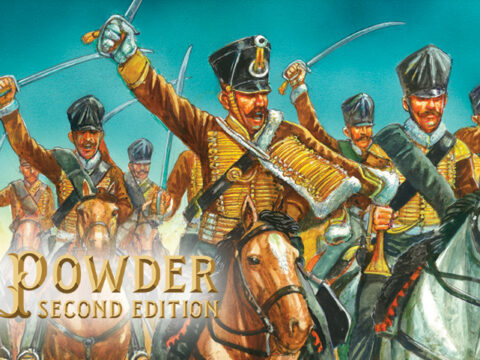The next stopping point on our whistle-stop tour of the Black Powder era is the Napoleonic Wars. This week, we’re taking a look at one of Napoleon’s first expeditions, an attempt to wrest control of the Mediterranean from the British and secure a passage to India by conquering Egypt and Syria.
In the wake of his dramatic success in Italy, Napoleon’s ambitions turned to thwarting the British in India and establishing a French colony in the Middle East. The Ottoman regime, which had ruled Egypt since 1517, had lost direct control of the country and were facing an open revolt from the Egyptian Mamluks.
After leaving Toulon with a force of 40,000 soldiers and 10,000 sailors in a fleet of 400 transport ships supported by a fleet of 27 warships. A dispute over reprovisioning at Malta led to Napoleon’s forces storming the island before moving on to land at Alexandria.
The Battle of the Pyramids
Unable to mount an effective defence of the city, the Mamluk defenders fled out into the desert. With the city secure, the French army marched on to Cairo. With the tops of the Pyramids in sight, Napoleon’s army of 25,000 men was checked by a force of 21,000 Mamluks, composed largely of cavalry.
WIth his baggage and artillery in train, Napoleon’s solution was to array his infantry into a giant square with the vulnerable baggage in the centre. Unable to penetrate the serried ranks of bayonet-wielding infantry, the Mamluk cavalry was driven off and routed. The French army entered Cairo the following night.
Now the safe harbour at Aboukir was secure, Napoleon ordered his transports to return home, leaving the warships anchored off the Egyptian coast. On 1st August, a squadron of Royal Navy warships intercepted the French fleet and destroyed them wholesale after slipping a detachment of warships between the French ships and the coast, hammering them from both sides.
Napoleon was undaunted, despite the loss of his fleet. Having temporarily pacified Cairo, Napoleon marshalled his forces and marched into Syria to blunt the Ottoman counter-attack. His campaign in Syria would last four months and bleed his army dry.
On his return to Egypt, Napoleon found yet another Ottoman army bearing down on Alexandria by land and by sea. Catching the Ottomans during their landing at Aboukir, the French army drove their disorganized opponents into the sea, destroying the whole army.
British Intervention
With the political situation in France rapidly deteriorating, and his stock improved by a series of decisive battles against the Ottomans, Napoleon decided to return to France. He slipped away by ship, leaving his forces under the command of General Kleber.
Despite negotiating a treaty with the Ottoman, Kleber found himself assailed on all sides by an Anglo-Ottoman alliance that landed an army of 30,000 men which moved swiftly to occupy Cairo. Kleber met the Ottomans at Heliopolis and defeated them.
While suppressing yet another revolt in Cairo, Kleber was assassinated by a Syrian student. Command of the embattled French forces passed to General Menou, just in time to face an army of newly-arrived British regulars.
The British landed at Aboukir on 8th March, packing wave after wave of troops into small boats and barges. Opposed by batteries of siege artillery, emplaced infantry and determined cavalry, the British managed to drive back the defenders and complete the rest of the landing unopposed.
Advancing towards Alexandria, the British forces were stalled at Mandara. In the ensuing battle, the British forces were flayed alive by French siege artillery on the heights of Nicopolis. Unable to advance in the face of the French resistance, the British retired to their original position.
The Battle of Alexandria
A week later, after a tense stalemate, the French launched an all-out attack on the British lines. Sweeping down off the heights, the French columns advanced across the open ground, screened by skirmishers and dragoons.
The brunt of the attack landed on the British right and centre, forcing gaps in the line around an area of Roman ruins and defensive earthworks. In the confusion, a vicious close quarter battle developed between several British and French regiments, eventually leading to the capture of a French standard, despite the best efforts of the French cavalry.
In the centre, steady volleys from the Guards regiments repulsed successive attacks by columns of French grenadiers and cavalry.
As the battle progressed, the fight around the ruins became steadily more confused. The 28th Foot found themselves engaged by infantry from the front, with a swirling mob of dragoons threatening their rear. Ordering the front rank to about-face, the regiment staved off the cavalry and earned the honour of wearing a cap badge on the front and back of their shakos.
With ammunition supplies dwindling, the British second line moved up in good order, plugging gaps and driving off the French cavalry. Confronted with a continuous line of bayoneted muskets, the French withdrew to Alexandria, where they endured a brief siege before surrendering and bringing the campaign to a close.
The Egyptian Campaign in Black Powder
Take the opportunity to explore the beginnings of Napoleon’s expert generalship and the first excursions of the nascent British army that would go on to dominate battlefields across India and the Peninsular. It’s an opportunity to try out some different basing techniques and create some interesting and evocative terrain pieces to represent the region.
If you know your stuff (and we’re sure many of you do), you’ll know that there aren’t any miniatures in our range that exactly represent the armies of this campaign (buttons and all), but if you’re looking at getting into Black Powder grabbing one of our fantastic Peninsular War era starter armies gives you plenty of miniatures to get started in a variety of theatres, giving you plenty of options for a whole variety of battles.
Get Black Powder 2!
Grab a copy of Block Powder from our webstore today, complete with a free Lucky Jack miniature!

